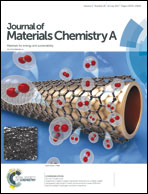Bioinspired interfacial reinforcement of polymer-based energetic composites with a high loading of solid explosive crystals†
Abstract
In this work, inspired by the strong chemical adhesion of mussels, a facile and noncovalent in situ polymerization of dopamine approach has been employed to coat 1,3,5-triamino-2,4,6-trinitrobenzene (TATB) crystals. The resultant polydopamine (PDA) coated TATB (pTATB) core–shell particles are subjected to in-depth characterizations. It has been demonstrated that a dense graphite-like structure PDA is uniformly coated on the surfaces of TATB crystals. By optimization of the reaction time, pH value and temperature, the morphology and thickness of the PDA layer on TATB crystals were finely controlled on a nanometer scale. Then, the pTATB was further used as the solid filler of a typical polymer bonded explosive (PBX). It has been shown that the PBX containing pTATB exhibited significantly improved tensile and compression strength or strain, and creep resistance, due to the strong interfacial interactions at the PDA interlayer. Moreover, the mechanical properties could be further improved by using more PDA content. This work demonstrates an effective and fundamental surface modification method to enhance the interfacial interaction between crystalline particles and binders, resulting in improved mechanical properties.


 Please wait while we load your content...
Please wait while we load your content...